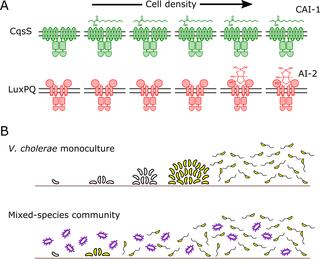当前位置:
X-MOL 学术
›
PLOS Biol.
›
论文详情
Our official English website, www.x-mol.net, welcomes your
feedback! (Note: you will need to create a separate account there.)
The intragenus and interspecies quorum-sensing autoinducers exert distinct control over Vibrio cholerae biofilm formation and dispersal.
PLOS Biology ( IF 7.8 ) Pub Date : 2019-11-11 , DOI: 10.1371/journal.pbio.3000429 Andrew A Bridges 1, 2 , Bonnie L Bassler 1, 2
PLOS Biology ( IF 7.8 ) Pub Date : 2019-11-11 , DOI: 10.1371/journal.pbio.3000429 Andrew A Bridges 1, 2 , Bonnie L Bassler 1, 2
Affiliation

|
Vibrio cholerae possesses multiple quorum-sensing (QS) systems that control virulence and biofilm formation among other traits. At low cell densities, when QS autoinducers are absent, V. cholerae forms biofilms. At high cell densities, when autoinducers have accumulated, biofilm formation is repressed, and dispersal occurs. Here, we focus on the roles of two well-characterized QS autoinducers that function in parallel. One autoinducer, called cholerae autoinducer-1 (CAI-1), is used to measure Vibrio abundance, and the other autoinducer, called autoinducer-2 (AI-2), is widely produced by different bacterial species and presumed to enable V. cholerae to assess the total bacterial cell density of the vicinal community. The two V. cholerae autoinducers funnel information into a shared signal relay pathway. This feature of the QS system architecture has made it difficult to understand how specific information can be extracted from each autoinducer, how the autoinducers might drive distinct output behaviors, and, in turn, how the bacteria use QS to distinguish kin from nonkin in bacterial communities. We develop a live-cell biofilm formation and dispersal assay that allows examination of the individual and combined roles of the two autoinducers in controlling V. cholerae behavior. We show that the QS system works as a coincidence detector in which both autoinducers must be present simultaneously for repression of biofilm formation to occur. Within that context, the CAI-1 QS pathway is activated when only a few V. cholerae cells are present, whereas the AI-2 pathway is activated only at much higher cell density. The consequence of this asymmetry is that exogenous sources of AI-2, but not CAI-1, contribute to satisfying the coincidence detector to repress biofilm formation and promote dispersal. We propose that V. cholerae uses CAI-1 to verify that some of its kin are present before committing to the high-cell-density QS mode, but it is, in fact, the broadly made autoinducer AI-2 that sets the pace of the V. cholerae QS program. This first report of unique roles for the different V. cholerae autoinducers suggests that detection of kin fosters a distinct outcome from detection of nonkin.
中文翻译:

属内和种间群体感应自诱导物对霍乱弧菌生物膜的形成和扩散起独特的控制作用。
霍乱弧菌拥有多个群体感应(QS)系统,可控制毒力和生物膜形成等其他特征。在低细胞密度下,当没有QS自诱导剂时,霍乱弧菌会形成生物膜。在高细胞密度下,当自诱导剂积累时,生物膜形成受到抑制,并发生分散。在这里,我们着重介绍两个并行运行的,具有良好特征的QS自诱导子的作用。一种叫做霍乱弧菌autoinducer-1(CAI-1)的自诱导物用于测量弧菌的丰度,另一种称为autoinducer-2(AI-2)的自诱导物是由不同的细菌种类广泛产生的,并被认为可以使霍乱弧菌成活。评估邻近社区的总细菌细胞密度。两个霍乱弧菌自动诱导剂将信息汇集到一个共享的信号中继路径中。QS系统架构的这一特性使得很难理解如何从每个自动诱导剂中提取特定信息,自动诱导剂如何驱动不同的输出行为,以及反过来,细菌如何利用QS来区分细菌群落中的亲属和非亲属。 。我们开发了一种活细胞生物膜形成和分散测定法,该方法可以检查两种自动诱导剂在控制霍乱弧菌行为中的个体作用和结合作用。我们表明,QS系统可作为巧合检测器,其中两个自动诱导剂必须同时存在,以抑制生物膜形成的发生。在这种情况下,当仅存在少量霍乱弧菌细胞时,CAI-1 QS途径被激活,而AI-2途径仅在高得多的细胞密度下被激活。这种不对称的结果是AI-2的外源而不是CAI-1的外源有助于满足巧合检测器的要求,以抑制生物膜的形成并促进扩散。我们建议霍乱弧菌在致力于高细胞密度QS模式之前使用CAI-1验证其亲属是否存在,但实际上,广泛使用的自动诱导剂AI-2决定了霍乱弧菌的发展步伐。霍乱弧菌QS程序。这份关于不同霍乱弧菌自动诱导物独特作用的首次报告表明,亲缘关系的检测与非亲缘关系的检测有明显区别。霍乱使用CAI-1来验证其某些亲属,然后再进入高细胞密度QS模式,但实际上,广泛使用的自动诱导剂AI-2决定了霍乱弧菌QS的步伐程序。这份关于不同霍乱弧菌自动诱导物独特作用的首次报告表明,亲缘关系的检测与非亲缘关系的检测有明显区别。霍乱使用CAI-1来验证其某些亲属,然后再进入高细胞密度QS模式,但实际上,广泛使用的自动诱导剂AI-2决定了霍乱弧菌QS的步伐程序。这份关于不同霍乱弧菌自动诱导物独特作用的首次报告表明,亲缘关系的检测与非亲缘关系的检测有明显区别。
更新日期:2019-12-03
中文翻译:

属内和种间群体感应自诱导物对霍乱弧菌生物膜的形成和扩散起独特的控制作用。
霍乱弧菌拥有多个群体感应(QS)系统,可控制毒力和生物膜形成等其他特征。在低细胞密度下,当没有QS自诱导剂时,霍乱弧菌会形成生物膜。在高细胞密度下,当自诱导剂积累时,生物膜形成受到抑制,并发生分散。在这里,我们着重介绍两个并行运行的,具有良好特征的QS自诱导子的作用。一种叫做霍乱弧菌autoinducer-1(CAI-1)的自诱导物用于测量弧菌的丰度,另一种称为autoinducer-2(AI-2)的自诱导物是由不同的细菌种类广泛产生的,并被认为可以使霍乱弧菌成活。评估邻近社区的总细菌细胞密度。两个霍乱弧菌自动诱导剂将信息汇集到一个共享的信号中继路径中。QS系统架构的这一特性使得很难理解如何从每个自动诱导剂中提取特定信息,自动诱导剂如何驱动不同的输出行为,以及反过来,细菌如何利用QS来区分细菌群落中的亲属和非亲属。 。我们开发了一种活细胞生物膜形成和分散测定法,该方法可以检查两种自动诱导剂在控制霍乱弧菌行为中的个体作用和结合作用。我们表明,QS系统可作为巧合检测器,其中两个自动诱导剂必须同时存在,以抑制生物膜形成的发生。在这种情况下,当仅存在少量霍乱弧菌细胞时,CAI-1 QS途径被激活,而AI-2途径仅在高得多的细胞密度下被激活。这种不对称的结果是AI-2的外源而不是CAI-1的外源有助于满足巧合检测器的要求,以抑制生物膜的形成并促进扩散。我们建议霍乱弧菌在致力于高细胞密度QS模式之前使用CAI-1验证其亲属是否存在,但实际上,广泛使用的自动诱导剂AI-2决定了霍乱弧菌的发展步伐。霍乱弧菌QS程序。这份关于不同霍乱弧菌自动诱导物独特作用的首次报告表明,亲缘关系的检测与非亲缘关系的检测有明显区别。霍乱使用CAI-1来验证其某些亲属,然后再进入高细胞密度QS模式,但实际上,广泛使用的自动诱导剂AI-2决定了霍乱弧菌QS的步伐程序。这份关于不同霍乱弧菌自动诱导物独特作用的首次报告表明,亲缘关系的检测与非亲缘关系的检测有明显区别。霍乱使用CAI-1来验证其某些亲属,然后再进入高细胞密度QS模式,但实际上,广泛使用的自动诱导剂AI-2决定了霍乱弧菌QS的步伐程序。这份关于不同霍乱弧菌自动诱导物独特作用的首次报告表明,亲缘关系的检测与非亲缘关系的检测有明显区别。









































 京公网安备 11010802027423号
京公网安备 11010802027423号